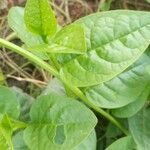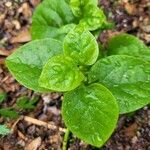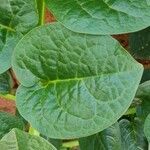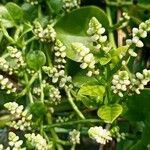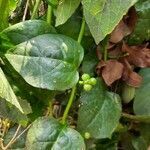Twining herbaceous vine or sometimes procumbent (creeping herb); stems 2–10 m long, succulent, pale green to purplish red, glabrous, mucilaginous, short-lived. Leaves: lamina usually ovate (often broadly so) to circular, 5–15 cm long, 2.5—12 cm wide, cuneate to cordate at base, entire, obtuse to shortly acuminate at apex, glabrous; petiole 1–3 cm long. Inflorescence axillary, spicate, un-or few-branched; spikes long-pedunculate, 5–28 cm long, succulent; bracts small, acute, persistent. Flowers fleshy, white to purple-pink, urceolate, not or scarcely opening (cleistogamous or nearly so); sepals 2, petalloid, obtuse, adnate to the perianth, persistent. Perianth 3–5 mm long, broad-tubular with an inflated base, 5-lobed towards the apex; lobes rounded. Stamens inserted near top of perianth, not emergent. Style tripartite to near base; stigmas 3, linear. Fruit tightly enclosed by the persistent fleshy perianth, globose, 4–8 mm diam., appearing shallowly 4-lobed, black, glossy. Seeds 1, globular.
Glabrous herb, becoming a slender, twining vine; stems green to red, at first stout, to 2 cm wide, later becoming tall and climbing to ca. 10 m long. Petiole to 8 cm long, sometimes absent; blade broadly ovate to elliptical, to 15 x 15 cm, undulate, apex acute to obtuse or rounded, base cuneate to truncate or cordate. Inflorescence of axillary or subterminal spikes, to 26 cm long; bracts broadly ovate to lanceolate, 1.1-2.3 mm long, acuminate, hyaline, 1-veined; flowers sessile; bracteoles calyx-like, 1-2 mm long, acute. Flowers not scented; tepals red, pink or white, united to above middle, urceolate to cylindrical, oblong to ovate, 2.0-5.2 x 2-2.5 mm long, obtuse; anthers oblong, sometimes subsagittate at base. Baccate drupe globose, when fresh to 7 mm diam., enveloped by enlarged, succulent perianth, dark purple or shining black, with violet juice; seed globose, 4 mm diam.
Glabrous annual or shortly lived perennial, succulent tangled twiner; stems much branched, 2–10 m. long, sometimes almost leafless, greenish or reddish.. Leaf-lamina ovate to suborbicular, (2–)5–15 cm. long, (l.25–)5–13.5 cm. broad, acute or acuminate (less commonly obtuse), usually widely cordate at the base; lateral nerves 4–5 on either side; petiole (1–)2.5–6.5 cm. long.. Flowers white, rose or purplish, (3–)4–5 mm. long, in long-peduncled spikes, 2.5–15(–25) cm. long, usually unbranched (in African specimens at least) but branched in some cultivated forms.. Perianth fleshy, urceolate, somewhat saccate at the base; lobes short, ovate, about one-third the length of the tube, not opening.. Fruits ± 0.5 cm. in diameter (4–7 × 5–10 mm. according to van Steenis), red, white or black; surface crinkly in the dry state.. Fig. 1/1–10.
An annual or perennial climbing herb with thick fleshy leaves. The vine is smooth and juicy and can be 10 m long. It branches freely. The vine and leaves can be red or green. The leaves are fleshy and pointed at the tip. They can be 8-18 cm long and 8-10 cm across. They are carried alternately along the vine. Leaves can be heart shaped or oval. It has white, pink or red flowers in short spikes which are in the axils of the leaves. Flowers have both sexes. The fruit are round and soft. They can be red, white or black and are 6-8 mm across. The seeds are round and black. They are 3 mm across. (Often the ones with heart shaped leaves are called Basella cordifolia, the ones with a red stem Basella rubra and the short day flowering dark green kind called Basella alba.)
Winding or creeping, 2-10 m long, up to 1 cm diam. Stems and petioles red (var. rubra), more rarely green (var. alba). Leaves broad-ovate to oblong, base shallow-cordate to acute, apex blunt to acute, somewhat succulent, green or purplish, 2-12 by 1.25-9 cm; petiole 1-3 cm. Spikes incl. the peduncle 3-25 cm, (in Mal. specim.) unbranched, with thick, red or green rhachis, flowers initially close together, gradually more spaced. Bracts ovate-triangular, acute, much shorter than the flower; bracteoles broad-elliptic, blunt, shorter than the bract. Flower with pale base and white, rose or purple, blunt apex, 3-4 mm long. Pseudo-berry depressed-globose, shallowly lobed, 4-7 mm high, 5-10 mm wide, shining black, containing a violet juice.
Herbs annual. Stems green or red, to 10 m, fleshy, glabrous. Petiole 1-3 cm; leaf blade ovate or rotund, 3-9 × 2-8 cm, base shallowly cordate or rotund, margin entire, apex acuminate. Spikes 3-15(-20) cm. Bracteoles oblong. Perianth red-dish or purplish, ovate-oblong, 3-4 mm, base pale, margin entire, apex blunt. Filaments white; anthers yellowish. Utricle red to dark red or black, 5-6 mm in diam., containing violet juice. Fl. May-Sep, fr. Jul-Oct.
Leaves: lamina 2.5–15 × 2.0–12.5 cm., ovate to circular, usually acute or acuminate, sometimes rounded or emarginate at apex, usually cordate at base, entire, lateral nerves 3–4 (5) on either side; petioles 0.5–9 cm. long.
Perianth somewhat fleshy, urceolate, lobes c. one-quarter length of tube, remaining closed.
Inflorescences axillary, long peduncled, usually unbranched spikes, 1.5–22 (30) cm. long.
Plant 1–8 m. tall; stems much branched, sometimes sparsely leaved, sometimes reddish.
A climber, cultivated in vegetable gardens; sometimes subspontaneous.
Flowers 2.5–6 mm. long, white, pink or mauvish.
Style with 3 linear stigmas, 0.5 mm. long.
Fruit 4–5 mm. diam., subglobose, black.
Stamens inserted near apex of tube.
Ovary 0.5 mm. tall, ovoid.
